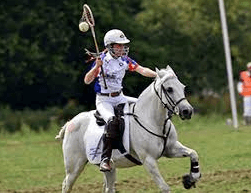What Are The Rules Of Polocrosse?

Polocrosse is a fast-paced and thrilling sport that combines elements of polo, lacrosse, and netball. Played on horseback with teams of six, it requires skillful coordination between the rider and their mount. This article aims to provide an in-depth understanding of the rules governing polocrosse, from equipment requirements to gameplay strategies.
To fully appreciate polocrosse, it is essential to understand the equipment used in the game. Each player must have a specially designed racquet called a ‘polocrosse stick’which features a netted pocket at one end for catching and throwing the ball. The ball itself is made of sponge rubber and is approximately four inches in diameter. Additionally, participants must wear appropriate safety gear such as helmets and boots to ensure their well-being during play.
In terms of gameplay, the objective of polocrosse is simple yet challenging: score goals by propelling the ball through the opposing team’s goal posts using only the polocrosse stick. However, there are several rules that govern how players can handle, pass, or intercept the ball. For instance, riders are not allowed to carry or throw the ball with their hands; instead, they must use their stick to pick up or catch it while riding at full speed. Moreover, players can block an opponent’s shot by positioning themselves between them and their intended target without making physical contact.
By familiarizing oneself with these rules of polocrosse, players can engage in fair play while experiencing an exhilarating sense of freedom on horseback. Whether you are new to this sport or already a seasoned player looking for further insights into its intricacies, this article will serve as your comprehensive guide to mastering polocrosse’s rules and regulations. So saddle up and get ready for an exciting journey into this unique equestrian discipline!
Equipment Requirements
Equipment requirements in polocrosse consist of a racquet, ball, and safety gear such as a helmet and protective eyewear.
Different types of polocrosse balls are used depending on the level of play and the field conditions. Standard polocrosse balls are made of rubber and weigh approximately 140 grams. These balls provide a good balance between speed and control during gameplay. However, for younger or less experienced players, softer balls made from foam or sponge may be used to reduce the risk of injury.
The proper use of safety gear is crucial in polocrosse to ensure the well-being of players. Helmets should be specifically designed for equestrian sports and must meet safety standards to protect against head injuries in case of falls or collisions. Protective eyewear is also recommended to shield riders’ eyes from flying debris or accidental hits by racquets or balls during intense gameplay.
Overall, adherence to equipment requirements and the use of appropriate safety gear play an important role in ensuring a safe and enjoyable polocrosse experience for all participants.
Gameplay and Objective
This section will discuss the key points related to gameplay and objectives in polocrosse.
Firstly, it is important to understand the field dimensions and goalposts used in polocrosse. The field is typically 146 meters long and 55 meters wide, with goalposts that are 3.5 meters apart.
Secondly, team composition and positions play a vital role in polocrosse. Each team consists of six players, divided into three positions: Number Ones, who are responsible for scoring goals; Number Twos, who act as midfielders; and Number Threes, who primarily defend the goalpost.
Lastly, scoring goals is the main objective of polocrosse. A goal is scored when a player successfully throws the ball through the opponent’s goalpost within the designated area.
Field dimensions and goalposts
Field dimensions and goalposts are essential elements of a polocrosse match, providing the boundaries and targets for players to navigate and score goals, despite their potentially vast scale. Polocrosse is typically played on a rectangular field that measures approximately 150 yards long and 60-80 yards wide. The field is divided into three sections: attack, midfield, and defense. Each section has its specific markings to guide players during gameplay.
The goalposts are positioned at each end of the field and consist of two uprights with a crossbar placed above them. The height of the goalposts can vary depending on the level of play but is usually around 4-5 feet high. Players must maneuver their horses within these dimensions while maintaining control of the ball and avoiding penalties such as crossing boundary lines or committing fouls against opponents.
Additionally, there are specific requirements for horses in polocrosse matches, including their size, temperament, fitness level, and equipment regulations to ensure fair play and safety for both horse and rider.
Team composition and positions
Team composition and positions in polocrosse are carefully structured to ensure a balanced and strategic approach to the game, allowing players to utilize their unique skills and contribute effectively to their team’s success.
In polocrosse, each team consists of six players divided into three main positions: Number 1, Number 2, and Number 3.
The Number 1 player is responsible for offense and scoring goals. They are typically the fastest and most agile player on the team, aiming to carry the ball across the opponent’s goal line while avoiding defenders.
The Number 2 player plays a dual role as both an offensive and defensive player. They assist the Number 1 in scoring goals while also helping defend against opposing attacks.
The Number 3 player primarily focuses on defense, aiming to prevent the opposing team from scoring by intercepting passes or defending against shots at goal.
Each position requires specific skills and responsibilities, creating a strategic gameplay where teamwork and coordination are essential for success.
By strategically assigning players to these positions based on their strengths, teams can optimize their gameplay strategy and increase their chances of winning matches in polocrosse.
Scoring goals
A crucial aspect of the game is the ability to score goals, prompting one to wonder: what strategies and techniques do players employ to successfully navigate their way past defenders and place the ball across their opponent’s goal line?
In order to maximize their chances of scoring, polocrosse players utilize a variety of training techniques, strategies, and tactics. Here are three key elements that contribute to successful goal-scoring in polocrosse:
1) Stickwork skills: Polocrosse players undergo extensive training in stickwork skills such as accurate passing, catching, and ball control. These skills enable them to maneuver the ball swiftly and precisely towards the opposing goal.
2) Tactical positioning: Players strategically position themselves on the field to create opportunities for scoring goals. They carefully assess the movement of defenders and exploit gaps in their formation to gain an advantageous position from which they can attempt a shot on goal.
3) Team coordination: Polocrosse is a team sport that requires seamless coordination among teammates. Players communicate effectively with each other during gameplay, using signals and verbal cues to coordinate their movements and execute planned plays. This teamwork ensures that players have support options when attempting a goal and increases the likelihood of success.
By honing their stickwork skills, employing tactical positioning, and maintaining strong team coordination, polocrosse players optimize their chances of scoring goals. These training techniques, strategies, and tactics enhance not only individual player performance but also contribute to overall team success in this exhilarating equestrian sport.
Rules and Fair Play
To ensure fair play and maintain a high level of sportsmanship, adherence to the established rules is crucial in polocrosse.
This sport emphasizes good sportsmanship and etiquette, where players are expected to treat their opponents with respect and uphold the integrity of the game.
Any form of penalty or misconduct is taken seriously, and consequences are enforced accordingly.
For instance, if a player commits a foul or violates a rule, penalties may be imposed such as awarding free shots to the opposing team or temporarily suspending the player from the game.
These measures aim to deter unsportsmanlike behavior and promote fair competition among players.
By following these rules and exhibiting good sportsmanship, polocrosse ensures an environment where freedom can be enjoyed within the boundaries of fair play.
Frequently Asked Questions
Are there any age restrictions for playing polocrosse?
Age restrictions for playing polocrosse exist, as the sport requires physical strength and skill. However, players of all ages can participate, with different divisions available based on age groups to ensure fair competition and safety.
Can polocrosse be played indoors?
Indoor polocrosse requires specific equipment, including a smaller field and softer balls. Playing indoors offers advantages such as protection from weather conditions and the ability to play year-round. However, it may limit the freedom of movement compared to outdoor play.
What are the typical dimensions of a polocrosse field?
Polocrosse field dimensions are crucial for setting up a proper game. The field is 60-100 yards wide and 160-200 yards long, resembling the vastness of an open plain that ignites the desire for freedom.
Are there different levels or divisions of polocrosse competitions?
Different levels of competition exist in polocrosse, with teams formed based on skill and experience. These divisions allow players to compete against others at a similar level, ensuring fair and challenging gameplay.
Can players use any type of horse for polocrosse or are there specific breeds preferred?
Different horse breeds are preferred for polocrosse due to their specific characteristics that enhance performance. Thoroughbreds are known for speed and agility, while Quarter Horses possess strength and maneuverability. These breeds contribute to the fast-paced, exhilarating nature of polocrosse.
Conclusion
Polocrosse is a fast-paced and exciting sport that combines elements of polo, lacrosse, and netball. It is played on horseback with teams consisting of six players each. The objective of the game is to score goals by throwing a ball through the opposing team’s goalposts.
In order to play polocrosse, certain equipment requirements must be met. Each player must have a stick called a ‘racquet’which has a net at one end for catching and throwing the ball. The ball used in polocrosse is made of rubber and weighs approximately 140 grams. Players are also required to wear protective gear such as helmets, knee pads, and boots.
During gameplay, teams compete against each other in four quarters lasting eight minutes each. The field is divided into three sections – attack, midfield, and defense – and players are assigned specific positions based on their skills and abilities. The game starts with a line-up where two players from each team face off for possession of the ball.
The rules of polocrosse ensure fair play and safety for all participants. Players are not allowed to hit or hook another player’s racquet during gameplay. They must also refrain from dangerous riding or actions that can cause harm to themselves or others. Fouls result in penalties such as free throws or penalty shots.
In conclusion, polocrosse is an exhilarating sport that requires skillful horsemanship and precise hand-eye coordination. With its unique combination of equestrian skills and team strategy, it offers an exciting experience for both players and spectators alike. So why not give this thrilling sport a try? Will you be able to master the art of catching and throwing while galloping at full speed?




